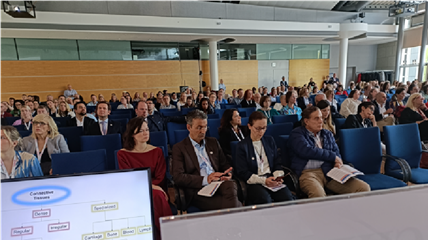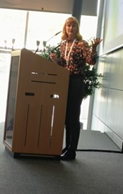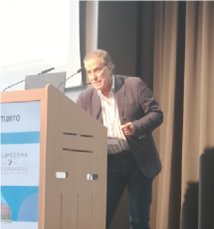Dr. Wright presented at the first World Congress on Lipedema, held in October 2023 in Potsdam, Germany. The common goal of this gathering was to share knowledge, experiences, and ideas related to the understanding and treatment of Lipedema and to benefit from first-hand, high-class education, network, and learn from world-renowned experts about the latest science and best practices in the management of lipedema.
The Lipedema World Congress is designed to bring together a broad spectrum of healthcare professionals, including lymphologists, plastic surgeons, angiologists, phlebologists, nutritionists, dermatologists, physical therapists, bariatric and Metabo specialists, and radiologists, as well as representatives of patient associates from around the world to share experiences and expertise on an international high-class level and to reflect on how to best incorporate these insights into education and clinical practice.
Dr. Wright gathered with peers from across the globe to learn the latest science and best practices in treating lipedema and shared his techniques and experiences treating patients. His presentation at the Lipedema World Congress was on how Lipedema Reduction Surgery Improves Mobility, Physical Function, and Multiple Measures of Quality of Life in Women with Lipedema.


World Congress on Lipedema, Potsdam, Germany, 4-7 October, 2023.
This is the first time Lipedema has had its own designated Congress, in which leading experts from over 35 countries gathered to discuss and learn about the disease. More than 500 participants testified that interest in the subject is constantly growing and is bringing important news to the international scientific community. The US-based Lipedema Foundation had a large presence at the Congress, bringing along their staff to share knowledge with the large group of attendees. The Lipedema Foundation alone funds around 10% of the research projects on the disease.
Lipedema World Congress: What Was Discussed?
Many colleagues from overseas also participated with great interest, and numerous representatives of patient associations from various countries joined the professionals. Attendees heard from Sharie Fetzer and Kate Forster of Lipedema UK, Valeria Giordano and Marcella Oggiano of LIO Lipedema Italia, representatives from American Fat Disorders, and leading experts representing Danish, Australian, Dutch, Swedish, Finnish, and Canadian foundations and practices.


World Congress on Lipedema, Potsdam, Germany, 4-7 October, 2023.
Lipedema World Congress: Day 1
Sessions began with live commentaries of surgical procedures on patients; those present could talk, discuss, and ask questions to the surgeons who illustrated their techniques. Dr. Fabio Kamamoto of Brazil began by illustrating the technique of laser ligation with simultaneous endovenous laser ablation (also referred to as EVLA). This was followed by Dr. Mojtaba Ghods and his Potsdam, Germany-based team demonstrating the Lymph-sparing Hybrid Technique: MicroAire PAL Large-Volume Liposuction and Manual Extraction in General Anaesthesia for Advanced Stages Lipedema.


Dr. Fabio Kamamoto illustrates the technique of Laser Liposuction with simultaneous endovenous laser ablation.
Dr. Ziah Taufig of Cologne, Germany, demonstrated the Human Med body-jet technique WAL Liposuction in General Anesthesia, followed by Dr. Barbara Herstant of Paris, France, who described with a video presentation the technique of VASER Liposuction + Renuvion J Plasma in General Anesthesia.


Dr. Ziah Taufig demonstrated the Human Med body-jet technique WAL Liposuction in General Anesthesia.
Finally, the first morning ended with a talk in the presence of our very own Dr. Thomas Wright, who illustrated his MicroAire PAL Liposuction in tumescent local anesthesia technique by video. The images alternating throughout the morning demonstrated how, with the application of effective techniques, the volumetric increase in the areas affected by Lipedema can be consistently reduced, with consequent benefits both functionally and on the symptoms related to the clinical picture.


Dr. Thomas Wright illustrated his MicroAire PAL Liposuction in tumescent local anesthesia technique at the World Lipedema Congress.
The afternoon session began with a presentation by Christine Moffat on the current state of care for patients with lipedema, which highlighted the serious deficiencies that exist in most public and private care systems worldwide. Several presentations on home self-management of the condition followed this. At the end of the first session, the co-chairs of the Congress reminded the audience that the disease was only a little over a year ago, finally recognized by the World Health Organization with its own code (EF.02.2) in the eleventh edition of the International Classification of Diseases, welcomed all those present to a packed and attentive hall.


Dr. M. Ghods Co-Chair


Dr. K. Herbst Co-Chair


Dr. S. Michelini Co-Chair
The second session on the conservative treatment of lipedema followed this. Several authors (Ure Christian, Michelini, Serena, and others) presented their experience, emphasizing the essential symptomatic aspect (although long-lasting and important in terms of symptom regression) of the treatments themselves.
In the third session, papers were presented on the status of genetic studies (still much to be investigated, even though the disease has clearly been revealed as hereditary), on biochemical studies, and on anatomical studies that are bringing us closer to a better understanding of the pathogenesis of the disease. Several authors took turns, including the Australian Rami Shayar and the Italian Saverio Cinti.
The fourth session, with presentations by José Luis Simarro, was devoted to the pathogenic hypotheses of the disease and, in particular, some of its symptomatological aspects, first and foremost, pain.


Dr. Simarro
The fifth and final session of the day was devoted to surgical treatment, particularly the various liposuction techniques, with the complementary aspects of using the various methods. Presentations were given by, among others, Thomas Wright and David Christel.


Dr. Wright
Lipedema World Congress: Day 2
On 6 October, the day began with the General Assembly of the Lipedema World Alliance. The first of its kind, the LWA is a new and innovative association set up in 2022, made up of healthcare professionals, patient associations, and scientific societies. The Association is supported, in part, by ‘founding donors’, including Juzo Italia, Juzo International, LeSearch, Medi International, and Tactile Medical. The LWA’s president, Sandro Michelini, shared the motivations and steps that led to the creation of the association, emphasizing their mission, operating methods, and organizational charter. He also announced the start of registering regular members alongside their founding members. Potential members can review and submit their information to join the LWA here. During the assembly, several proposals were made, including that of organizing, if possible, a ‘dedicated’ international congress every two years in different locations.
The following session was devoted to the relationship between Lipedema and Obesity, which once again highlighted the fact that the association between the two pathologies is neither constant nor interdependent and that, in the case of obesity associated with Lipedema, bariatric surgery, which has a good effect on the classic sites of accumulation of adipose tissue, does not have such an effect in the anatomical sites affected by Lipedema itself.
The next session was followed by the presenter describing in more detail the aims of the Lipedema World Alliance. Johnatan Kartt described the activities of the Lipedema Foundation, which are mainly aimed at supporting scientific research. Dr. Karen Herbst and Dr. Gabriele Faerber then described the American and German Lipedema guidelines. Dr Faerber also compared the main consensus documents currently in place. During the lunch break, there was the opportunity to follow extra-congressional work with the description of other surgical experiences (WAL and other techniques) by several alternating specialists.
That afternoon, the resumption of proceedings was devoted to nutritional aspects; the presentations showed that the ketogenic diet (Giovanna Pitotti, Malgorzata Jeziorek, and other authors) and ‘low carb’ are the most effective dietary regimes in the disease. This was followed by the session on epidemiological and diagnostic aspects, with speakers touching on differential diagnosis aspects (Rachelle Crescenzi, Epameinondas Gousopoulos, and other speakers), including that between Lipedema, lipohypertrophy, and Secondary Lymphoedema. The last session highlighted the possible interactions between Lipedema and the lymphatic system. It featured other important and well-known speakers such as Stanley Rockson, Alberto Onorato, Jean-Paul Belgrado, and Hakan Brorson.


International experts possible interactions between Lipedema and the lymphatic system.
The evening ended with the Gala Dinner, during which the Lipedema Foundation honored Ghods for his scientific and care commitment. There were also some truly uplifting moments of fellowship and fun, during which it was possible to deepen mutual understanding between the various participants, as well as on some of the topics discussed after the presentations.


The Founder’s Dinner for the Founders of Lipedema World Alliance.
Lipedema World Congress: Day 3
Saturday morning began with a plenary discussion on the results of the first two steps of the Delphi study, which was so well attended that it lasted for much of the coffee break time. The lively and substantive discussion led to the final draft [ of the contents of the paper that will be published in the coming weeks.
Lipedema World Congress Delphi Consensus Statements
Dr. Kruppa prepared 100 statements about lipedema to review by the participants, and prior to the meeting, the statement had been modified and winnowed to 69 statements. The open session was chaired by Dr. Michelini, Dr. Kruppa, and Dr. Cresscenzi. During this time, Dr. Wright and nearly 100 experts worldwide discussed and debated the consensus statements.
The goal of this important project is to define what is agreed to be understood in the field of lipedema research and treatment. Also, to point out areas where more research and coordination are needed. The results of this work are hoped to produce a position paper focusing on lipedema coordinated by the Lipedema World Alliance. This document aims to comprehensively cover various aspects of lipedema, including its nature, epidemiology, pathophysiology, diagnosis, and treatment approaches. The intention is to create a resource that assists healthcare professionals, researchers, funders, and individuals impacted by lipedema in understanding the current opinions of experts and gaps in knowledge and management of the condition.


Left to Right: Dr. Crescenzi, Dr. Kruppa, and Dr. Michelini preside over the Delphi consensus discussions.
This position paper is the basis and starting point for further areas to be explored as they relate to lipedema. Given the evolving nature of lipedema research and the varying degrees of evidence available, reaching a unanimous consensus in certain areas might prove challenging. Acknowledging this, the project will employ a multi-step Delphi method to facilitate expert collaboration. This method will enable the group to iteratively evaluate and refine statements related to lipedema based on the current literature and collective expertise.
The last conference sessions followed this, the first of which was dedicated to basic science, histology, and molecular analysis. Among the various papers presented, the one by Cannataro, who, with the coordination of the writer, carried out on tissue samples selected and taken by the Plastic Surgeon Nicola Vaia in Rome, together with his wife Erika Cione (biochemist at the University of Cosenza), showed the data of a preliminary study that highlighted the presence of an ‘up-regulator’ micro-RNA as a possible ‘marker’ of the disease, arousing lively interest in those present (at the moment, the diagnosis of the disease is essentially clinical).


Dr. Cannataro explains data from a preliminary study that highlights the presence of an ‘up-regulator’ micro-RNA as a possible ‘marker’ of Lipedema.
The last session was again dedicated to various liposuction procedures. Various speakers took turns (including Agostino Bruno, Enriquez Burgos, Uwe Wollina, Corrado Cesare Campisi, Thomas Su, and others), highlighting some aspects relating to the effectiveness of the techniques and the sparing of other anatomical structures (first and foremost, the loco-regional lymphatic system).
As already mentioned, one of the novelties of the Congress was the role of the patients’ associations, which was much appreciated. This participation was precisely in the spirit advocated also by the WHO, of sharing the experiences of healthcare professionals with patients’ associations and, above all, finalizing the collaboration itself to the drafting of consensus documents useful in clinical practice and functional for recognition at the level of individual country governments.
Lipedema World Congress: Looking Ahead
The first World Congress on Lipedema upheld its promise to be an unparalleled gathering of experts and stakeholders in the field. Dr. Wright was honored to contribute his knowledge, learn from renowned experts, and collaborate with peers worldwide. Together, they’re paving the way for advancements in the understanding and management of lipedema.
About Dr. Wright
Dr. Thomas Wright is a leading expert in venous and lymphatic medicine, with 15+ years of experience dedicated to advancing lipedema treatment. As the medical director of Laser, Lipo, and Vein Center, he’s among the first 200 US surgeons to attain diplomat status with the American Board of Venous and Lymphatic Medicine. He is a Fellow of the American Venous and Lymphatic Society. His research contributions include peer-reviewed papers on lipedema and co-authoring the US Lipedema Standard of Care Guidelines. Dr. Wright’s expertise covers lipedema reduction surgery, fat transfer, and minimally invasive skin tightening. Trained by Dr. Jeffrey Klein, he has performed thousands of tumescent liposuction procedures for cosmetic and lipedema patients, collaborating with institutions like Washington University and the University of Arizona to deepen our understanding of lipedema.




